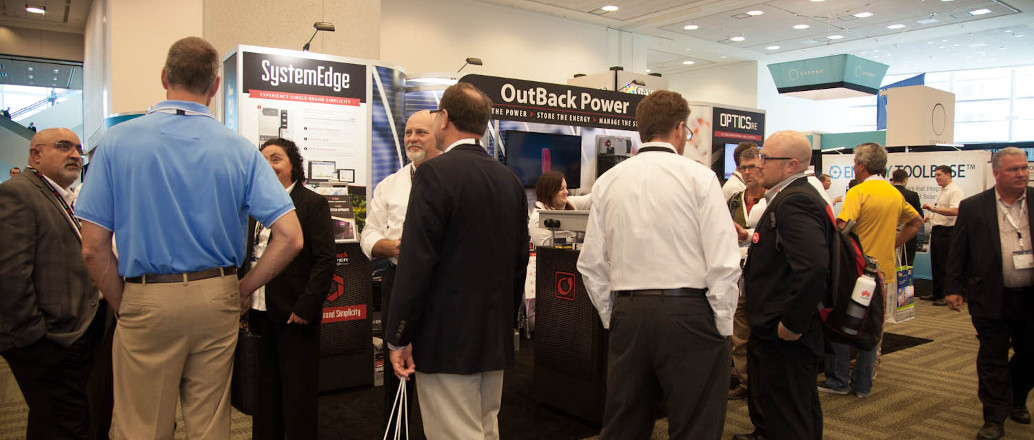The 9th Intersolar North America trade show has concluded in San Francisco, marking another year of growth for the dynamic U.S. market, with a strong view to the future on the heels of the extension of the federal Investment Tax Credit.
From our view from the floor of the show, we bring you four key takeaways:
1) The intersection with battery storage is an increasingly important part of the solar industry.
While there was a 10% increase in demand for floor space overall, this year the smart energy and energy storage portion of the Intersolar North America exhibition grew 20%. Additionally, a number of new products and partnerships were announced, most notably Sonnen announcing a commercial & industrial (C&I) solution in partnership with Ideal Power Converters.
This is on the back of both market and policy progress. GTM Research has predicted that this will be a breakout year for energy storage in the United States, and during the event the Solar Foundation released a new report which forecasts that the intersection of solar and energy storage will create an additional 27,000 new U.S. jobs by 2021.
These trends are driven by concrete technical considerations, as increasing penetrations of solar and wind on the grid conflict with inflexible conventional generation. For the leading state of Hawaii, concerns about high penetrations of solar have led the state to replace net metering with a self-consumption policy, essentially mandating the pairing of energy storage with distributed PV.
2) Policy fights get more intense
Even during the dawn of solar as the cheapest source of electricity generation, solar PV markets are still at the mercy of policy, especially distributed solar. Battles over net metering and specifically the danger of “another Nevada” weighed heavy on many in this years’ show, particularly during the opening session.
The long-term trends here are clear, and as Just Energy Senior VP Jeff Wolfe noted at an Impress Labs panel discussion, net metering is not going to be around forever. Even in states like California, while the big private utilities are under net metering 2.0, certain municipal utilities and co-ops such as Imperial Irrigation District have already replaced retail net metering with wholesale renumeration.
It is not clear that the solar industry is ready to deal with these coming changes. Some parts of the industry appear to be caught like a deer in headlights, and huge divisions remain between those who think that the industry needs to move to a “value of solar” concept for renumeration, versus those who are fighting tooth-and-nail to preserve retail-rate net metering.
3) Trackers on the rise
But as fights over policies for distributed generation heat up, utility-scale solar continues to boom in the United States, both for large projects in emerging markets like Texas, the growing community solar segment, and increasing corporate and utility procurement of solar PV around the country.
As part of this change, trackers are being used ever more widely in the U.S. utility-scale market, not only in their traditional markets in the Southwest but also in emerging markets such as the Midwest. The growing importance of tracking technology was reflected by a strong presence at this years’ show by industry leaders including NEXTracker, Array Technologies and Soltec.
Notably, during the show SolarFlexRack launched its TDP tracker product, which it says that is the “only tracker solution provided with full design, installation, and commissioning services”.
4) Solar is getting smarter
Along with the growing importance of energy storage, there is the increasing use of solar PV and storage to provide services to the grid, and the increasing integration of PV and storage with electric vehicles, smart thermostats and other devices as part of the “smart home” concept.
Among the developments at Intersolar North America was a new partnership between JLM Energy and Honeywell to help homeowners on time-of-use rates avoid energy use peaks using the combination of JLM’s Energizr 200 Energy Storage and Management system along with Honeywell’s Lyric smart thermostat.
Amidst all these signs of industry progress, a dark cloud appeared on Wednesday night, as news broke that a court has sided with Hemlock Semiconductor in a key aspect of a case against a subsidiary of Germany’s SolarWorld, which could put SolarWorld on the hook for over $700 million in damages.
This content is protected by copyright and may not be reused. If you want to cooperate with us and would like to reuse some of our content, please contact: editors@pv-magazine.com.









2 comments
By submitting this form you agree to pv magazine using your data for the purposes of publishing your comment.
Your personal data will only be disclosed or otherwise transmitted to third parties for the purposes of spam filtering or if this is necessary for technical maintenance of the website. Any other transfer to third parties will not take place unless this is justified on the basis of applicable data protection regulations or if pv magazine is legally obliged to do so.
You may revoke this consent at any time with effect for the future, in which case your personal data will be deleted immediately. Otherwise, your data will be deleted if pv magazine has processed your request or the purpose of data storage is fulfilled.
Further information on data privacy can be found in our Data Protection Policy.